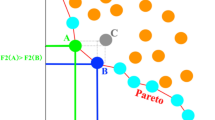Abstract
Evolutionary multi-objective optimization has established itself a core field of research and application, with a proliferation of algorithms derived. During the multi-objective optimization processes, the discovered ideal solutions should be diversely distributed at the Pareto front. In order to measure and compare the performances of different multi-objective evolutionary algorithms, or provide a guidance for the search or a stopping criterion, various performance metrics are defined and used. In this paper, two of the most commonly used metrics, the spacing metric and the overall Pareto spread metric, which evaluate the uniformity and the range of the Pareto solutions’ distribution are studied, respectively. A new distribution metric which potentially can combine these two metrics and resolve their deficiencies for comparing Pareto optimal solutions is then proposed. Five typical Pareto fronts and a real practical example are used to demonstrate the effectiveness of the proposed metric by comparing with the subject matter experts’ ratings.









Similar content being viewed by others
Abbreviations
- EMO:
-
Evolutionary multi-objective optimization
- MOEA:
-
Multi-objective evolutionary algorithm
- SP:
-
Spacing metric
- OS:
-
Overall Pareto spread metric
- DM:
-
Distribution metric
- SME:
-
Subject matter expert
- H :
-
The number of objectives
- S :
-
The obtained non-dominated solutions
- |S|:
-
The number of the obtained non-dominated solutions
- f h (s):
-
The function values of the h th objective at current solutions s
- d i :
-
The distance measure in the SP
- \( \overline{d} \) :
-
The mean value of d i
- P B :
-
The Utopia design points
- P G :
-
The Nadir design points
- σ h :
-
The standard deviation of all distances obtained in the DM corresponding to the h th objective
- μ h :
-
The mean of all distances obtained in the DM corresponding to the h th objective
- R h :
-
The range of function values corresponding to the h th objective
- d′ h e :
-
The distance value of the eth interval between two adjacent solutions corresponding to the h th objective in the DM
References
Branke J, Deb K, Miettinen K, Slowiński R (eds) (2008) Multiobjective optimization: interactive and evolutionary approaches, vol 5252. Springer
Deb K, Pratap A, Agarwal S, Meyarivan TAMT (2002) A fast and elitist multiobjective genetic algorithm: NSGA-II. IEEE Trans Evol Comput 6(2):182–197
Fonseca CM, Fleming PJ (1993) Genetic algorithms for multiobjective optimization: formulation discussion and generalization. ICGA 93:416–423
Gunzburer M, Burkdart J (2004) Uniform measures for point samples in hypercube. From http://people.sc.fsu.edu/~burkardt/pdf/ptmeas.pdf
Horn J, Nafpliotis N, Goldberg DE (1994) A niched Pareto genetic algorithm for multiobjective optimization. In: Evolutionary Computation, 1994. IEEE World Congress on Computational Intelligence., Proceedings of the First IEEE Conference on, pp 82–87. Ieee
Knowles JD, Corne DW (2000) Approximating the nondominated front using the Pareto archived evolution strategy. Evol Comput 8(2):149–172
Lotov A, Bushenkov VA, Kamenev GK (2013) Interactive decision maps: approximation and visualization of Pareto frontier, vol 89. Springer Science & Business Media
Makowski M (2004) Multi-objective decision support including sensitivity analysis. Encyclopedia of life support systems, pp 1–24
Schott JR (1995) Fault tolerant design using single and multicriteria genetic algorithm optimization (No. AFIT/CI/CIA-95-039). AIR FORCE INST OF TECH WRIGHT-PATTERSON AFB OH
Shi L, Fu Y, Yang RJ, Wang BP, Zhu P (2013) Selection of initial designs for multi-objective optimization using classification and regression tree. Struct Multidiscip Optim 48(6):1057–1073
Srinivas N, Deb K (1994) Muiltiobjective optimization using nondominated sorting in genetic algorithms. Evol Comput 2(3):221–248
Tahernezhadiani K, Hamzeh A, Hashemi S (2012) Towards enhancing solution space diversity in multi-objective optimization: a hypervolume-based approach. Int J Artif Intell Appl 3(1):65
Ulungu EL, Teghem JFPH, Fortemps PH, Tuyttens D (1999) MOSA method: a tool for solving multiobjective combinatorial optimization problems. J Multicrit Decis Anal 8(4):221
Utyuzhnikov SV, Fantini P, Guenov MD (2009) A method for generating a well-distributed Pareto set in nonlinear multiobjective optimization. Comput Appl Math 223(2):820–841
Van Veldhuizen DA (1999) Multiobjective evolutionary algorithms: classifications, analyses, and new innovations (No. AFIT/DS/ENG/99-01). AIR FORCE INST OF TECH WRIGHT-PATTERSONAFB OH SCHOOL OF ENGINEERING
Wu J, Azarm S (2001) Metrics for quality assessment of a multiobjective design optimization solution set. J Mech Des 123(1):18–25
Zhang WH, Gao T (2006) A min–max method with adaptive weightings for uniformly spaced Pareto optimum points. Comput Struct 84(28):1760–1769
Zitzler E, Thiele L (1998) Multiobjective optimization using evolutionary algorithms—a comparative case study. In: Parallel problem solving from nature—PPSN V, pp 292–301. Springer Berlin Heidelberg
Zitzler E, Deb K, Thiele L (2000) Comparison of multiobjective evolutionary algorithms: empirical results. Evol Comput 8(2):173–195
Zitzler E, Laumanns M, Thiele L (2002) Spea2: improving the strength Pareto evolutionary algorithm for multiobjective optimization. Evolutionary Methods for Design, Optimization, and Control, pp 95–100
Zitzler E, Thiele L, Laumanns M, Fonseca CM, Da Fonseca VG (2003) Performance assessment of multiobjective optimizers: an analysis and review. IEEE Trans Evol Comput 7(2):117–132
Acknowledgments
This work was supported by the National Natural Science Foundation of China (Nos. 51475288, 51275293), “ShuGuang” project supported by Shanghai Municipal Education Commission and Shanghai Education Development Foundation (12SG14), US Ford Motor Company and ESTECO North America.
Author information
Authors and Affiliations
Corresponding author
Appendix
Appendix
(Table 8).
Rights and permissions
About this article
Cite this article
Zheng, K., Yang, RJ., Xu, H. et al. A new distribution metric for comparing Pareto optimal solutions. Struct Multidisc Optim 55, 53–62 (2017). https://doi.org/10.1007/s00158-016-1469-3
Received:
Revised:
Accepted:
Published:
Issue Date:
DOI: https://doi.org/10.1007/s00158-016-1469-3




